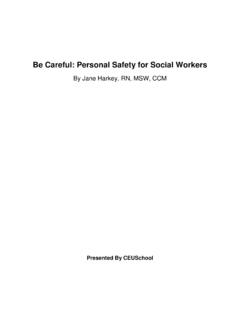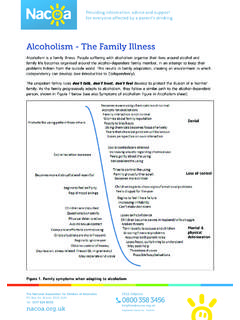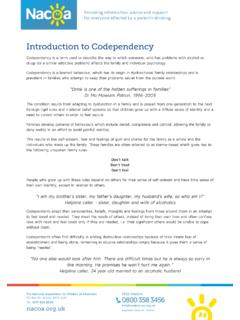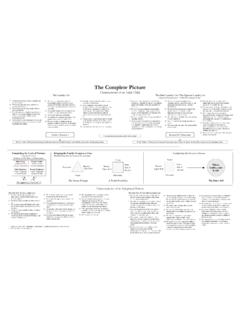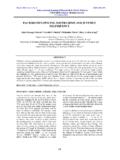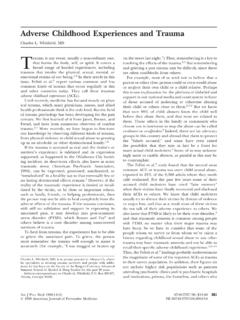Transcription of Incest and Child Sexual Abuse: Understanding and …
1 Incest and Child Sexual abuse : Understanding and Treating By Diana Castillo, BA PSYCH, MSSW, LCSW. Presented by CEUS chool Author Information Diana Castillo, BA, MSSW, LCSW is an Independent Clinical Social Worker currently Licensed in Florida. She specialized in treating Incest and Child Sexual abuse . This encompasses many other diagnoses, which she sub-specialized in. These include Depression, Eating disorders, Post Traumatic Stress Disorder, and others. She has worked as a Psychotherapist in Community Mental Health Clinic settings, in Private Psychiatric Hospitals and Independent Practice for over 20 years.
2 2. Course Summary This course will provide mental health professionals with the knowledge to Understanding and treating Incest and Child Sexual abuse , including the definition, statistics, symptoms, diagnosis and diagnosing challenges, treatment and challenges involved in the treatment. The course material has been collected from current literature as well as time proven materials and the author's many years of experience in working with Incest and Child Sexual abuse .. 3. Course Objectives After completion of this course the professional will be able to: 1. Define Incest and Child Sexual abuse 2.
3 Discuss the statistics and prevalence of Incest and Child Sexual abuse 3. Learn some common characteristics of the perpetrator 4. Learn some common characteristics of the incestuous family 5. Identify the symptoms and aftereffects of this trauma 6. Interview and Find Diagnoses for Incest and Child Sexual abuse and concurrent related disorders 7. Identify treatment options and modalities for the trauma 8. Learn some treatment challenges of the trauma 9. Identify concurrent disorders that can be present as a result of Incest or Child Sexual abuse 10. Locate resources for survivors of Incest and Child Sexual abuse 4.
4 Outline 1. Definitions of Incest and Child Sexual abuse 2. Prevalence and Statistics 3. Characteristics of the Perpetrator 4. Characteristics of Incest Families 5. Symptoms and Aftereffects 6. Interviewing and Diagnosing 7. Challenges in Interviewing the Victim 8. Treatment and Challenges to Treatment 9. Resources 10. Bibliography 5. PART 1: Definitions of Incest and Child Sexual abuse Incest was once a taboo subject but in the past almost 40 years it has come to be a widely researched topic. The women's liberation movement, increased divorces and single working mothers brought it out in the open as children were more exposed to Sexual abuse .
5 (Crewdson, 1988, p. 25) In order to fully understand this trauma it is necessary to first learn the definitions of Incest and Child Sexual abuse . Some definitions of Incest and Child Sexual abuse are: Incest is Sexual intercourse between blood relatives , the imposition of sexually inappropriate acts or acts with Sexual overtones by one or more persons who assert authority and power over that Child through ongoing emotional bonding with that Child . (Blume, 1990, p. 4) The persons referred to are called perpetrators. These persons can be parents and/or other family members, siblings, peers, teachers, religious representatives, or babysitters for examples.
6 It has been asserted that the most prevalent form of Child Sexual abuse and the one with the most potential for damage and harm to the Child is the Incest between an adult and a related Child or adolescent. (Courtois, 1988, p. 12). The difference between Child Sexual abuse and Incest is that in Incest the perpetrator is family and with Child Sexual abuse it can be by anyone. Sexual abuse of a Child has been traditionally been considered Incest or pedophilia but it is now viewed on a continuum rather than either or. According to (Able, 1983) 44% of incestuous men who are having Sexual contact with their own children are also having 6.
7 Sex with other children outside the home and who they are not related to. PART 11: Prevalence and Statistics According to Diana Russell (The Secret Trauma) and David Finkelhor ( Child Sexual abuse ), girls are abused by men 95% of the time and boys are abused by men 80% of the time. (Bass and Davis, 1988, ) Child Sexual abuse has been written about and discussed for many years although not as openly as it is now. Freud was the first to identify mental health issues in adult survivors of childhood Sexual abuse . (Russell. 1986, p. 4-6). The late 40's to early 50's Kinsey studies did identify the largest number of Incest cases but actually minimized the trauma that this should cause and urged the public that children should not be upset by these experiences.
8 Kinsey attributed trauma as the result of adults' own attitudes towards it as causing hysteria. The control and power aspects were ignored and were simply advocating men's greater Sexual proclivity. (Herman, 1981, p. 16-18) The public was apparently not ready to deal with this issue. (Encyclopedia or Social Work, 1987, p. 256), (Lew, 2004, pp. 100-140). What brought Incest and Child Sexual abuse to the forefront in the l970's was the women's liberation movement. At that time domestic violence, rape and Child Sexual abuse were finally in the spotlight. Diana Russell conducted a random study in San Francisco.
9 Nine hundred women were interviewed about their Sexual abuse experiences as children. The results were that 38% were abused by relatives, friends or strangers under the age of 18. (Crewdson, 1988, p. 25) In 1985, Bud Lewis conducted a poll . The sample was 2,627 males and females from all over the US. He found that 7. 27% of women and 16% of men reported early Sexual abuse . That was 38 million victims. (Crewdson, 1988, p. 27-28) One in three girls and one in seven boys are sexually abuse by age 18. (Bass and Davis, 1988, p. 20) The typical Sexual offender molests 117 children on average, and most do not report the offense (NIMH, 1988).
10 When Incest and Child Sexual abuse was examined out of the United States there are staggering numbers. Many other countries however sanction Incest and Child Sexual abuse as rites of passage or normal activities for the health or pleasure of adults, to help the Child sleep better, to teach the Child about sex and the justifications are numerous. These studies will not be treated in this course but mention of it is for future study by the professionals wishing to pursue studies of differing cultural behaviors and treatment of children. 8. PART 111: Characteristics of the Perpetrator There are characteristics that Child Sexual perpetrators seem to have in common just from observation and recent attention to this factor.
